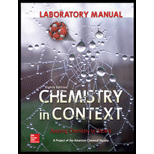
Concept explainers
In each pair below, the [H+] is different. By what factor of 10 is it different?
- a. pH = 6 and pH = 8
- b. pH = 5.5 and pH = 6.5
- c. [H+] = 1 × 10−8 M and [H+] = 1 × 10−6 M
- d. [OH−] = 1 × 10−2 M and [OH−] = 1 × 10−3 M
(a)
Interpretation:
By what factor of 10 will be different for the given pair has to be determined.
Concept introduction:
The
The difference in pH is by one unit, then the change in
Explanation of Solution
Given pH of the solutions are
The pH difference between the two solutions is 2.
pH of the solution can be calculated using the given equation,
The difference in pH is by one unit, then the change in
Therefore, solution having
(b)
Interpretation:
By what factor of 10 will be different for the given pair has to be determined.
Concept introduction:
The
The difference in pH is by one unit, then the change in
Explanation of Solution
Given pH of the solutions are
The pH difference between the two solutions is 1.
pH of the solution can be calculated using the given equation,
The difference in pH is by one unit, then the change in
Therefore, solution having
(c)
Interpretation:
By what factor of 10 will be different for the given pair has to be determined.
Concept introduction:
The
Explanation of Solution
Given that
pH of the solution can be calculated using the given equation,
The pH difference between the two solutions is 2.
The difference in pH is by one unit, then the change in
Therefore, solution having
(c)
Interpretation:
By what factor of 10 will be different for the given pair has to be determined.
Concept introduction:
The
The difference in pH is by one unit, then the change in
Relationship between
Explanation of Solution
Given that
The difference in pH is by one unit, then the change in
pH of the solution with
pH of the solution with
The pH difference between the two solutions is 1.
Therefore, solution having
Want to see more full solutions like this?
Chapter 6 Solutions
Laboratory Manual Chemistry in Context
Additional Science Textbook Solutions
Principles of Chemistry: A Molecular Approach (3rd Edition)
Organic Chemistry
Fundamentals of Heat and Mass Transfer
Chemistry: The Central Science (13th Edition)
Inorganic Chemistry
General, Organic, and Biological Chemistry - 4th edition
- Chemistry: Bonding 4a. Draw the Lewis structure for CH4, (methane), NH3, (ammonia), and H20 (water). b. Calculate the bond polarity for the C-H bond, N-H bond, and O-H bond. c. Classify these molecules as either polar or nonpolar. If the molecule is polar, label the partial negative and partial positive sides of the molecules you drew above.arrow_forward7. What do you mean by “aliquot” and “dilution”?arrow_forwardZn + 2 HCl ------> ZnCl2 + H2 2) When HCl(aq) is poured over the zinc metal, the liquid begins to fizz with small bubbles. What are the bubbles made of? Combustion Tests of Hydrogen –arrow_forward
- 3. Which of the properties listed here are characteristic of an ionic bond? low melting point good electricity conductor as a solid dissolves in water to form a solution that contains mostly ions dissolves to form a solution that contains mostly molecules good electricity conductor when melted forms solid crystals i,iii,iv ii,v,vi iii,v,vi ii,iii,v i,iii,viarrow_forwardCalculate the number of moles of Cl- ions in 1.75 L of 1.2 *10-3 M ZnCl2.arrow_forwardTake about 5 ml of dil. HCl in a test tube and add a few pieces of fine granules to it.Which gas is evolved?(a) Chlorine(b) Hydrogen(c) HCl(d) Nitrogenarrow_forward
- Consider this list of substances: H2O, Ni, KI, CH4. Match these substances with the properties below. Question 9 options: Conducts electricity as a solution in water Consists of a molecule with a tetrahedral electron pair geometry Conducts electricity in the solid state Can undergo hydrogen bonding with water . H2O . Ni . KI . CH4arrow_forwarddetermine the correct way to write the chemical formula for calcium carbonate in water? CaCO3(aq) (Ca)3CO3(aq) (Ca)2CO3(s) (Ca)3CO3(s) (Ca)2CO3(aq) or CaCO3(s)arrow_forwardMg (s) + ½O2 (g) → MgO (s) (1)This equation can be obtained by combining equations (2), (3) and (4) below:MgO (s) + 2HCl (aq) → MgCl2 (aq) + H2O (l) (2)Mg (s) + 2HCl (aq) → MgCl2 (aq) + H2 (g) (3)H2 (g) + ½ O2 (g) → H2O (l) (4) Combine equations (2), (3) and (4) to obtain equation (1).arrow_forward
 Chemistry for Engineering StudentsChemistryISBN:9781337398909Author:Lawrence S. Brown, Tom HolmePublisher:Cengage LearningChemistry: Matter and ChangeChemistryISBN:9780078746376Author:Dinah Zike, Laurel Dingrando, Nicholas Hainen, Cheryl WistromPublisher:Glencoe/McGraw-Hill School Pub Co
Chemistry for Engineering StudentsChemistryISBN:9781337398909Author:Lawrence S. Brown, Tom HolmePublisher:Cengage LearningChemistry: Matter and ChangeChemistryISBN:9780078746376Author:Dinah Zike, Laurel Dingrando, Nicholas Hainen, Cheryl WistromPublisher:Glencoe/McGraw-Hill School Pub Co Chemistry: An Atoms First ApproachChemistryISBN:9781305079243Author:Steven S. Zumdahl, Susan A. ZumdahlPublisher:Cengage Learning
Chemistry: An Atoms First ApproachChemistryISBN:9781305079243Author:Steven S. Zumdahl, Susan A. ZumdahlPublisher:Cengage Learning


